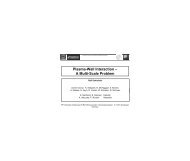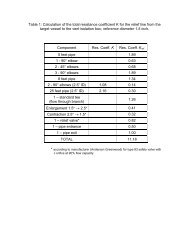The Nu-SNS proposal - ORNL Physics Division - Oak Ridge ...
The Nu-SNS proposal - ORNL Physics Division - Oak Ridge ...
The Nu-SNS proposal - ORNL Physics Division - Oak Ridge ...
Create successful ePaper yourself
Turn your PDF publications into a flip-book with our unique Google optimized e-Paper software.
A program of neutrino cross section measurements that are important for understanding<br />
nucleosynthesis as well as supernova dynamics would follow these initial measurements on iron<br />
and carbon. This program is extremely cost effective since the sensitive components can be<br />
reused with new target materials. For example, a measurement of the neutrino cross section on<br />
16 O could be performed in the liquid detector by exchanging the mineral oil with water with<br />
minimal added expense. Measurements of the neutrino cross section on lead, which is important<br />
for understanding how neutrinos may effect the synthesis of heavy elements and for<br />
understanding the response of terrestrial supernova neutrino detectors, could be performed with<br />
only the added cost of the lead target material. Accurate neutrino cross section measurements on<br />
such relatively simple nuclei spanning a wide mass range (A = 16, 58, and 208) would be a<br />
crucial first step toward assessing and eventually improving the reliability of neutrino-nucleus<br />
cross section calculations. Measurements on lighter, odd-Z nuclei (such as aluminum in the<br />
segmented detector) and a very precise measurement of the neutrino cross section on deuterium<br />
(using heavy water in the liquid detector) would be excellent candidates for the next set of<br />
measurements. <strong>The</strong>re is also strong interest in testing supernova neutrino detector prototypes at<br />
the ν-<strong>SNS</strong> facility.<br />
<strong>The</strong> choice and ordering of targets is determined by many factors, both scientific and practical.<br />
Given the broad interest in neutrino cross section measurements and the wide array of potentially<br />
interesting targets and detectors, we envision that ν-<strong>SNS</strong> would be a user facility with a Program<br />
Advisory Committee to make recommendations as to priorities for the scientific program beyond<br />
the initial set of measurements on iron, water and mineral oil targets.<br />
2.6 High Level Cost and Schedule<br />
Table 2.1 shows the estimated unescalated costs for top-level project components in FY05 $K.<br />
<strong>The</strong> total comes to $8,575K, with $2,022K (31%) contingency. We estimate an additional $440K<br />
in Other Project Costs (preparation of a conceptual design report, R&D and pre-ops). With a<br />
Total Project Cost (TPC) exceeding $5M, ν-<strong>SNS</strong> must adhere to DOE Order 4.13.3. We believe<br />
the construction project can be completed in a period of three years. <strong>The</strong> profile resulting from<br />
these considerations in as-spent dollars (including escalation) is shown in Figure 2.7. From this<br />
we can derive the ν-<strong>SNS</strong> TPC of $9,934K.<br />
Table 2.1 Unescalated ν-<strong>SNS</strong> cost summary for top-level work breakdown<br />
structure elements (in FY05 $K).<br />
WBS #<br />
Title<br />
Cost w/o<br />
Contingency Contingency Total<br />
Contingency<br />
Fraction<br />
1.1 Bunker 2,256 564 2,819 25%<br />
1.2 Veto 1,059 377 1,436 36%<br />
1.3 Segmented Detector 1,155 427 1,582 37%<br />
1.4 Homogeneous Detector 1,189 452 1,641 38%<br />
1.5 Utilities 229 62 291 27%<br />
1.6 Safety System 63 17 80 27%<br />
1.7 DAQ 258 64 323 25%<br />
1.8 Project Management 344 59 403 17%<br />
Total 6,553 2,022 8,575 31%<br />
ν-<strong>SNS</strong> Proposal 14 8/4/2005


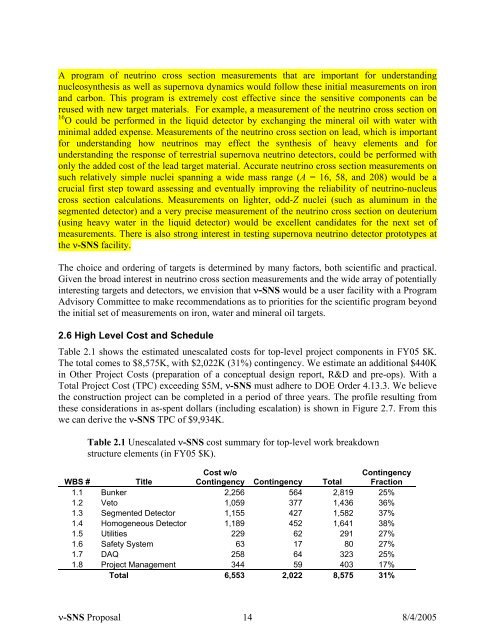
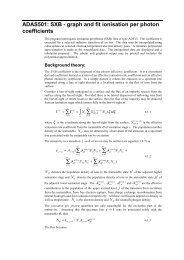
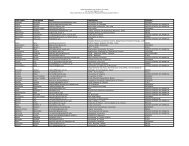
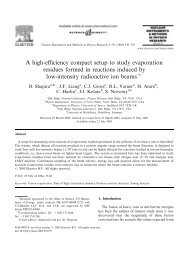
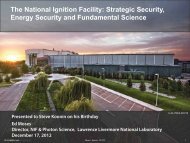

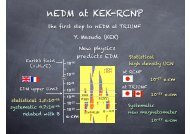
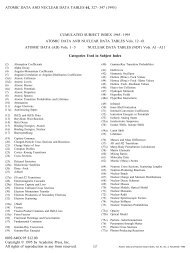


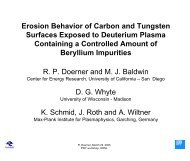
![Mixed-mode Calculations within the Nuclear Shell Model [pdf]](https://img.yumpu.com/28265410/1/190x146/mixed-mode-calculations-within-the-nuclear-shell-model-pdf.jpg?quality=85)
